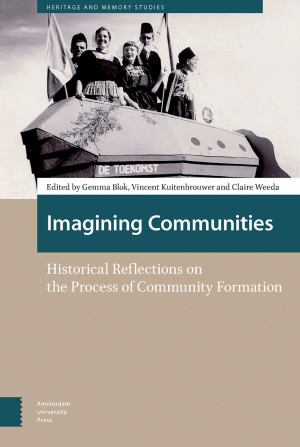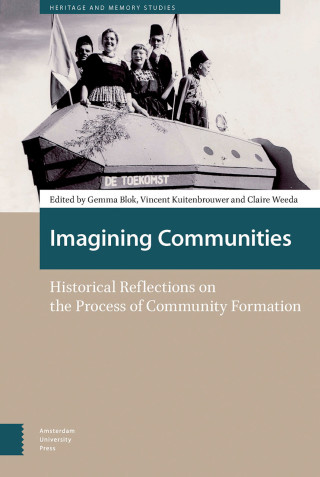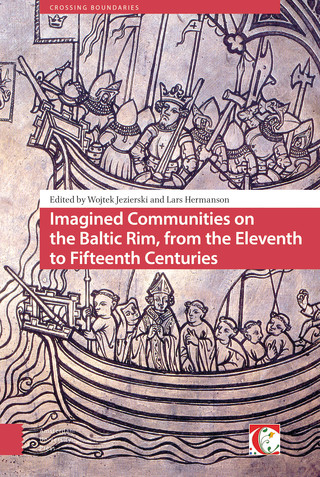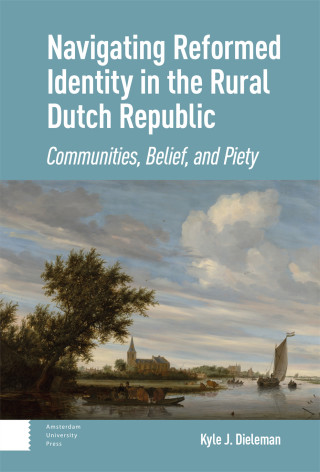

- Title
- Imagining Communities
- Subtitle
- Historical Reflections on the Process of Community Formation
- Price
- € 121,99
- ISBN
- 9789048529162
- Format
- eBook PDF (Adobe DRM)
- Number of pages
- 252
- Language
- English
- Publication date
- 24 - 07 - 2018
- Dimensions
- 15.6 x 23.4 cm
- Partner

- Category
- Modern History
- Discipline
- History, Art History, and Archaeology
- Also available as
- Hardback - € 122,00
Introduction by Gemma Blok, Vincent Kuitenbrouwer and Claire Weeda (editors)
1. Claire Weeda, ‘Meanwhile in Messianic Time: Imagining the Medieval Nation in Time and Space and English Drinking Rituals’
2. Suze Zijlstra, ‘Diverse Origins and Shared Circumstances: European Settler Identity Formation in the Seventeenth-Century Plantation Colony of Surinam’
3. Lotte Jensen, ‘Imagining Europe: The Peace of Ryswick (1697) and the Rise of European Consciousness’
4. Krisztina Lajosi, ‘Gypsy Music and the Fashioning of National Community’
5. Gemma Blok, ‘Tired, Worried and Overworked: An International Imagined Community of Nervous Sufferers in Medical Advertisements, 1900-1920’
6. Vincent Kuitenbrouwer, ‘From Heart to Heart’: Colonial Radio and the Dutch Imagined Community, 1920s’
7. Klaas Stutje, ‘Indonesian Nationalism in the Netherlands, 1920s-1930s: Long-Distance Internationalism of Elite Pilgrims in Homogeneous, Empty Time’
8. Marleen Rensen, ‘Time, Rhythm and Ritual: Imagined Communities in L’espoir (1937) and Les sept couleurs (1939)’
9. Barbara Henkes, Stamverwantschap and the Imagination of a White, Transnational Community: the 1952 Celebrations of Jan van Riebeecks Tercentanary in the Netherlands and South Africa’
10. Niek Pas, ‘‘L’Oranie Cycliste, une grande famille’: Recycling Identities and the Pieds-Noirs Communitas 1976-2016’
11. Alexander Dhoest, ‘Remembering and Imagining the National Past: Public Service Television Drama and the Construction of a Flemish Nation, 1950-1980’
Imagining Communities
Historical Reflections on the Process of Community Formation
In his groundbreaking Imagined Communities, first published in 1983, Benedict Anderson argued that members of a community
experience a Ÿdeep, horizontal camaraderie.Œ Despite being strangers, members feel connected in a web of imagined experiences.
Yet while Anderson’s insights have been hugely influential, they remain abstract: it is difficult to imagine imagined communities. How do they evolve and how is membership constructed cognitively, socially and culturally? How do individuals and communities contribute to group formation through the act of imagining? And what is the glue that holds communities together?
Imagining Communities examines actual processes of experiencing the imagined community, exploring its emotive force in a number of case studies. Communal bonding is analysed, offering concrete insights on where and by whom the nation (or social group) is imagined and the role of individuals therein. Offering eleven empirical case studies, ranging from the premodern to the modern age, this volume looks at and beyond the nation and includes regional as well as transnational communities as well.
Yet while Anderson’s insights have been hugely influential, they remain abstract: it is difficult to imagine imagined communities. How do they evolve and how is membership constructed cognitively, socially and culturally? How do individuals and communities contribute to group formation through the act of imagining? And what is the glue that holds communities together?
Imagining Communities examines actual processes of experiencing the imagined community, exploring its emotive force in a number of case studies. Communal bonding is analysed, offering concrete insights on where and by whom the nation (or social group) is imagined and the role of individuals therein. Offering eleven empirical case studies, ranging from the premodern to the modern age, this volume looks at and beyond the nation and includes regional as well as transnational communities as well.
Editors
Gemma Blok
Gemma Blok is a professor in the History of Mental Health and Culture at the Open University of the Netherlands. Her areas of expertise are the histories of psychiatry, addiction treatment, and drug use. She was a principal investigator in the HERA-funded project Governing the Narcotic City. Imaginaries, Practices and Discourses of Public Drug Cultures in European Cities from 1970 until Today.
Vincent Kuitenbrouwer
Vincent Kuitenbrouwer is assistant professor at the History Department of the University of Amsterdam. He is specialized in the history of modern imperialism with a particular focus on colonial media.
Claire Weeda
Claire Weeda works as an assistant professor at the History Department of Leiden University. She is specialized in ethnic identity, medicine, and community formation in the period 1100-1500.
Related titles

Imagining Communities
Gemma Blok, Vincent Kuitenbrouwer, Claire Weeda (eds)

Imagined Communities on the Baltic Rim, from the Eleventh to Fifteenth Centuries
Wojtek Jezierski, Lars Hermanson (eds)

Rethinking the Republic of Letters
Koen Scholten

Navigating Reformed Identity in the Rural Dutch Republic
Kyle Dieleman
